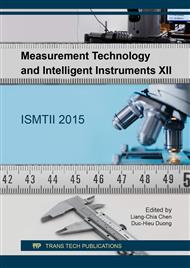p.323
p.329
p.335
p.342
p.351
p.357
p.363
p.369
p.375
Brain Activity Monitoring System Based on EEG-NIRS Measurement System
Abstract:
Recently, near infrared spectroscopy (NIRS) is widely applied on brain activation energy monitoring and adopted in clinical experiments. The advantages of NIRS are its non-invasive measurement and lower electrical disturbances. To verify the covariance and correlation of electroencephalography (EEG) and NIRS, an EEG-NIRS measurement system is implemented for data collection. The EEG and NIRS signals are recorded by common EEG electrodes and specific wavelength optical sensors. The EEG and NIRS sensors are placed with staggered placement to keep the same space resolution. EEG signal is processed with an instrument amplify, a band-pass filter circuit and variable gain amplifier, sequentially. The red light and near infrared light generated by LEDs are projected onto the tissues. Base on the blood oxygen-level dependence, the reflected photons can transfer the information of brain oxygen concentration. The NIRS signal acquired by two optical sensors is converted to voltage and filtered by a band-pass filter. In this measurement system, time-division multiplexing technique is applied on NIRS data collection to get the concentration of oxygenated hemoglobin and deoxy-hemoglobin. So, light sources and optical detectors are controlled by a signal processor. The post process data is digitalized and transferred to personal computer for brain activity estimation. The brain activity is extracted from the EEG and NIRS signal, individually. In this experiment, the EEG and NIRS signals are checked and analyzed. Although two kinds of brain activation indexes are resulted by different signal transfer path, the consistence response approves that the NIRS can be considered to monitor the brain activity. The easily setup of NIRS measurement can bring us more freedom of brain information extraction.
Info:
Periodical:
Pages:
351-356
Citation:
Online since:
September 2017
Authors:
Price:
Сopyright:
© 2017 Trans Tech Publications Ltd. All Rights Reserved
Share:
Citation:


